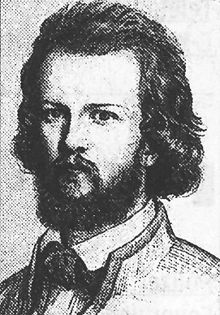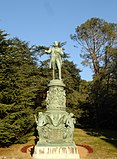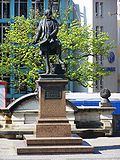Johannes Schilling
Johannes Schilling (born June 23, 1828 in Mittweida , † March 21, 1910 in Klotzsche near Dresden ) was a German sculptor .
Life
Johannes Schilling was born in 1828 as the fifth child of the authorized signatory Julius Schilling and Anna Schilling, geb. Praße, born in Mittweida, comes from the noble Schilling family . One year after his birth, his parents went to Dresden, where Johannes Schilling grew up. At the age of six he attended the private school Böttchers am Altmarkt and at the age of 14 came to the art academy in Dresden , where, among other things, Karl Gottlieb Peschel taught him drawing. After completing his studies, he became one of the master students of the sculptor Ernst Rietschel in 1845 and worked for five years in his studio in the Brühl garden pavilion . In the years 1851 and 1852 Schilling stayed in Berlin, where he was tutored by Christian Daniel Rauch and Johann Friedrich Drake .
In 1852 he returned to Dresden and worked and learned until 1854 in the studio of the sculptor Ernst Julius Hähnel . He then went on a research trip to Rome, from which he returned in 1856. In 1857, Schilling set up his own studio in Dresden and took his first orders for buildings by Gottfried Semper, among others . In the same year Johannes Schilling married Louise Isidora Arnold, the daughter of the publisher Ernst Sigismund Arnold, in Dresden . From this marriage, among others, Rudolf Schilling , the architect and co-owner of the construction company Schilling & Graebner , and Katharina Susanna Schilling, the future wife of the chemist Arthur Hantzsch . The writer and historian Heinar Schilling came from his second marriage to Minna Auguste Natalie Neubert .
In 1861 Johannes Schilling was commissioned to design the stairs for the Brühl Terrace , which was completed in 1868. The group of figures made of sandstone Four Times of the Day was replaced by bronze casts in 1908, the originals are now on the Schlossteich in Chemnitz. The four times of day was the breakthrough as a sculptor for Johannes Schilling. Numerous other orders followed, which took him across Europe. Central works were also created in Dresden, where Schilling created the quadriga of the Semperoper and the equestrian statue for King John of Saxony .
In Dresden, Johannes Schilling was appointed professor at the Art Academy in 1868, where he taught until shortly before his death. His students included Carl Schlueter , Jakob Otto Schweizer and George Simonds . Already during his lifetime a Schilling Museum was opened on Pillnitzer Strasse in Dresden around 1888, built according to the plans of his son Rudolf , which belonged to the municipal collections and in which plaster models and designs by Johannes Schilling were exhibited. The museum was destroyed in 1945. He bequeathed part of his artistic legacy to his hometown Mittweida on condition that he set up his own Schilling Museum. However, this was not realized by the First World War . It was not until 2005, after almost 100 years, that his legacy was fulfilled through the Schilling House in his hometown. Johannes Schilling is one of the artists who are represented in the last group of the Fürstenzug in Dresden, which was completed in 1907 in its current form .
Johannes Schilling died in 1910 in Klotzsche, today a district of Dresden, and was buried in the Trinitatisfriedhof . He was later transferred to Meißen - Zscheila in the Schilling family grave in the crypt of the local Protestant church.
Work (selection)
Sculptures
1860 Judgment and Peace Angel on the Cross, grave monument for Fam. Haenel, Inner Neustädter Friedhof Dresden
1861–1868: The four times of the day on the Brühl Terrace in Dresden
1868–1876: Ernst Rietschel monument on the Brühl Terrace in Dresden
1870–1875: Archduke Ferdinand Maximilian monument in the park of Miramare near Trieste
Until 1877: War memorial 1870/71 of the 2nd Hanseatic Infantry Regiment No. 76 , current location: Hamburg-Rotherbaum
1877–1883: Niederwald Monument . Schilling's younger daughter Clara is said to have been the model for Germania.
1882–1883: Reformation monument in Leipzig
1882–1889: Equestrian statue for King John of Saxony
1888–1894: Memorial to Kaiser Wilhelm I in Wiesbaden
1891/92: Gottfried Semper monument on the Brühl Terrace in Dresden
1897–1903: Kaiser Wilhelm Monument in Hamburg , 1930 relocated to Planten un Blomen
Johannes Schilling also provided the draft for Friedrich Schiller's statue on Schillerplatz in Vienna, which was executed by Franz Pönninger . Works such as the monuments to Prince Bismarck (1899–1901, Gotha) or to King Albert of Saxony (1900–1903, Crimmitschau) no longer exist. Johannes Schilling also created numerous grave sculptures, such as those for Franz Ludwig Gehe and Richard Hartmann ; Schilling created a total of around 280 sculptures in Germany, Austria, France and Italy. His statue of Christ from 1859 is in the Christ Church in Klotzsche . In 1996 over 1000 drawings were given to the Kupferstichkabinett Dresden as permanent loan by the heirs of Johannes Schilling .
Fonts
- Johannes Schilling: Artistic Visual Studies . Voigtländer, Leipzig 1906, new edition 2010
Awards (selection)
- 1864: Honorary member of the Royal Art Academy Dresden
- 1867: Honorary member of the Royal Art Academy in Munich
- 1874: Bavarian Maximilian Order for Science and Art
- 1877: Honorary citizen of the city of Mittweida
- 1883: Honorary citizen of the city of Dresden
- 1882: Pour le Mérite for science and art
- 1889: Commander's Cross II. Class of the Royal Saxon Order of Merit
literature
- Constantin von Wurzbach : Schilling, Johannes . In: Biographisches Lexikon des Kaiserthums Oesterreich . 29th part. Imperial-Royal Court and State Printing Office, Vienna 1875, p. 326 f. ( Digitized version ).
- Commemorative publication for the 100th birthday of Johannes Schilling . Monse & Rasch, Bautzen 1928.
- Bärbel Stephan: The Saxon sculptor Johannes Schilling (1828–1910). A contribution to the history of German sculpture in the 19th century . Univ. Diss., Halle-Wittenberg 1988.
- Bärbel Stephan: Saxon Sculpture, Johannes Schilling: 1828-1910 . Verlag für Bauwesen, Berlin 1996, ISBN 3-345-00494-1 .
- Bärbel Stephan: Schilling, Johannes. In: New German Biography (NDB). Volume 22, Duncker & Humblot, Berlin 2005, ISBN 3-428-11203-2 , p. 769 f. ( Digitized version ).
- City administration Mittweida (ed.): Johannes Schilling (1828–1910): inventory catalog of the Schilling collection Mittweida, especially the plastic collection . Stadtarchiv / Stadtmuseum Mittweida, Mittweida 2003.
- Eric Bawor (Ed.): Johannes Schilling. Artistic vision studies - works . Verlag Schilling & Kappelar, Bautzen 2010, ISBN 978-3-9813529-0-0 .
Web links
- Literature by and about Johannes Schilling in the catalog of the German National Library
- Literature by and about Johannes Schilling in the Saxon Bibliography
- Site plan of the monument on a hand drawing by Schilling in the architecture museum of the TU Berlin
- Website of the Verband des Haus Schilling eV with information on Johannes Schilling
- Article in Stadtwiki Dresden
Individual evidence
- ^ Bärbel Stephan: Schilling, Johannes. In: New German Biography (NDB). Volume 22, Duncker & Humblot, Berlin 2005, ISBN 3-428-11203-2 , p. 769 f. ( Digitized version ).
- ↑ Burckhardt Helferich: Hantzsch, Arthur. In: New German Biography (NDB). Volume 7, Duncker & Humblot, Berlin 1966, ISBN 3-428-00188-5 , p. 641 f. ( Digitized version ). on the other hand names Schilling's older daughter Katharina as a model for Germania.
| personal data | |
|---|---|
| SURNAME | Schilling, Johannes |
| BRIEF DESCRIPTION | German sculptor |
| DATE OF BIRTH | June 23, 1828 |
| PLACE OF BIRTH | Mittweida |
| DATE OF DEATH | March 21, 1910 |
| Place of death | Klotzsche near Dresden |

















